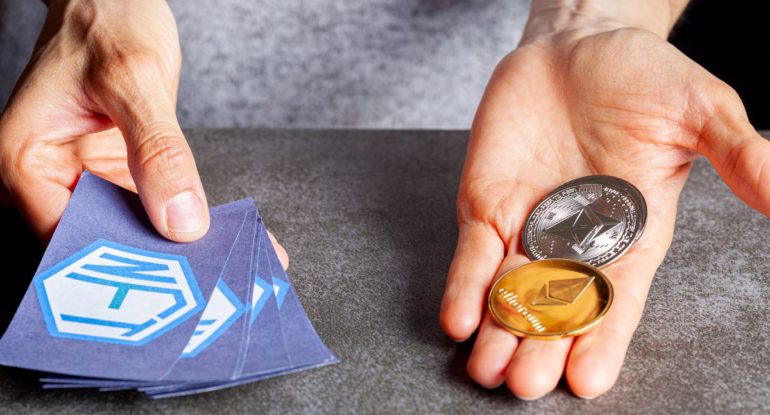Understanding NFT Staking Implementation: A Guide To A Growing Trend

Non-Fungible Tokens (NFTs) have taken the digital world by storm, enabling the ownership and trading of unique digital assets. But there’s a new trend in the NFT space that’s gaining traction – NFT staking. In this article, we’ll explore what NFT staking is, how it works, and the potential benefits and risks associated with this emerging concept.
What is NFT Staking?
NFT staking is a novel concept that combines Non-Fungible Tokens with the DeFi (Decentralized Finance) ecosystem. It allows NFT holders to lock up or “stake” their tokens for a specific period in exchange for rewards. These rewards can come in various forms, including cryptocurrency, additional NFTs, governance tokens, and more.
In essence, NFT staking turns your static digital collectibles into productive assets. It adds a layer of utility and income potential to NFT ownership beyond merely showcasing or trading them.
How NFT Staking Works
NFT (Non-Fungible Token) staking is a relatively new concept in the blockchain and cryptocurrency space. It combines the principles of staking, common in various blockchain networks, with the unique properties of NFTs. Staking, in a traditional sense, involves locking up cryptocurrencies or tokens to support network operations and earn rewards. NFT staking takes this idea a step further by allowing NFT holders to lock up their unique digital assets for a specified period in exchange for rewards. These rewards can include cryptocurrencies, tokens, additional NFTs, or even governance rights within a decentralized platform. Let’s dive into how NFT staking works:
1. Selecting a Staking Platform:
To begin with NFT staking, you need to choose a suitable staking platform. Various platforms and projects offer NFT staking opportunities. You should select one that supports the specific NFTs you own or wish to stake. Ensure that the platform is reputable and secure, as you’ll be entrusting your valuable NFTs to it.
2. Staking Commitment:
Once you’ve chosen a platform, you’ll need to decide which NFTs you want to stake and for how long. Staking duration can vary, and some platforms offer flexibility in this regard. You might be able to stake for a few days, weeks, months, or even years, depending on the platform’s terms and the specific project.
3. Locking NFTs:
After choosing the NFTs and staking duration, you’ll lock up your NFTs in a smart contract provided by the staking platform. These NFTs are no longer tradable or transferable during the staking period. The smart contract ensures that your NFTs are secure and that they are returned to you once the staking period is over.
4. Earning Rewards:
During the staking period, your NFTs contribute to the platform’s ecosystem. In return, you receive rewards based on the platform’s reward structure. Rewards are typically in the form of cryptocurrencies or tokens native to the staking platform. The amount and frequency of rewards may vary and can depend on factors like the total staked NFTs, the duration of the stake, and the overall network activity.
5. Withdrawal and Unstaking:
Once the staking period concludes, you can withdraw your staked NFTs and any earned rewards. This process is known as “unstaking” your NFTs. Unstaking allows you to regain control and liquidity over your NFTs, making them available for trading, holding, or restaking if you choose.
6. Managing Your Staked NFTs:
While your NFTs are staked, you can monitor their status and the rewards they’re generating. Many staking platforms provide dashboards and interfaces to keep track of your assets and rewards. It’s essential to manage your staked NFTs and rewards to make informed decisions about reinvesting or cashing out.
Also, read – Are NFTs The Future Of Blockchain Gaming. Top 10 Ways NFTs Are Making Money For Blockchain Gaming
Benefits of NFT Staking
1. Passive Income:
NFT staking provides a source of passive income for NFT holders. By locking up their assets, they can earn rewards without actively trading or engaging in other DeFi activities.
2. NFT Utility:
Staking adds utility to NFTs, making them more than just collectibles. It gives users a reason to hold and interact with their NFTs beyond mere ownership.
3. Liquidity Options:
Staked NFTs can be unstaked, allowing users to regain control and liquidity over their assets. This flexibility is crucial, especially for those who want to sell or trade their NFTs.
4. Diversification:
NFT staking allows users to diversify their digital asset portfolio. They can stake NFTs from different projects and maximize their potential rewards.
Demystifying NFT Staking: Uncover the art of earning passive rewards with your digital treasures! 🚀💰https://t.co/YWd4upatmo#Staking101 #web3 #blockchain
— NFT Trader (@NftTrader) October 11, 2023
Risks and Considerations
While NFT staking offers enticing opportunities, it comes with its set of risks and considerations:
1. Loss of Liquidity:
Staking involves locking up NFTs for a specific period, potentially limiting your ability to trade or use them during that time.
2. Platform Risk:
The staking platform you choose should be reputable and secure. There’s a risk of scams or vulnerabilities in less-established platforms.
3. Project Viability:
The NFT project you’re staking with may not succeed or fulfill its promises, affecting the value of your staked NFTs and rewards.
4. Impermanent Loss:
If the value of the cryptocurrency or tokens earned during staking fluctuates significantly, you may experience impermanent loss when converting them back to your desired assets.
Conclusion
NFT staking is an innovative convergence of Non-Fungible Tokens (NFTs) and the decentralized finance (DeFi) landscape. It introduces an exciting avenue for NFT collectors and investors to extract passive income from their unique digital assets while granting these assets a newfound utility beyond simple ownership. While NFT staking presents enticing rewards in the form of cryptocurrencies, tokens, and even additional NFTs, it’s essential to exercise due diligence, select reputable staking platforms, and consider the potential loss of liquidity and price fluctuations. As NFT staking continues to evolve, it is expected to play an increasingly significant role in the blockchain industry, reshaping how we perceive and utilize digital collectibles.




























































